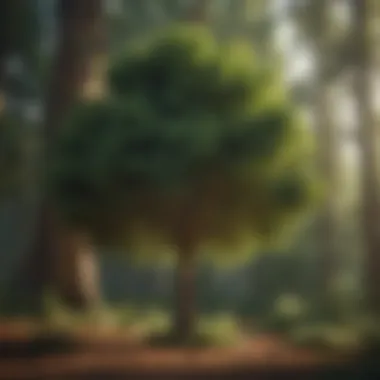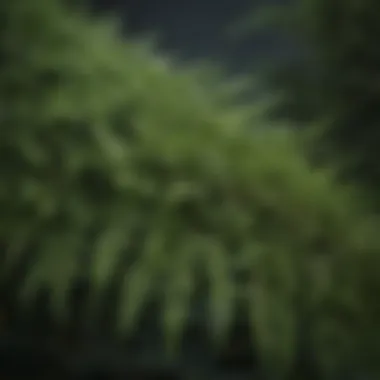Exploring the Growth Dynamics of the Junior Giant Thuja Tree


Intro
The Junior Giant Thuja tree is a notable species known for its impressive size and unique characteristics. Understanding its growth potential and requirements is essential for anyone involved in landscaping, horticulture, or conservation efforts. This article explores various dimensions of the Junior Giant Thuja tree, including its size dynamics, care needs, and implications in environmental management.
Overview
Common Name and Scientific Classification
The Junior Giant Thuja, scientifically known as Thuja plicata, is a member of the Cupressaceae family. This tree is commonly referred to as Western Red Cedar. Its classification places it among some of the most sought-after species for both ornamental and functional purposes in landscapes.
Physical Characteristics
The Junior Giant Thuja can reach heights of up to 30 feet, and its width can extend significantly under optimal conditions. The foliage is evergreen, displaying rich green to yellowish hues throughout the year. Notably, the tree's bark is fibrous and aromatic, adding to its appeal in various applications.
Habitat and Distribution
Native primarily to the western regions of North America, this tree thrives in moist, well-drained soils and prefers partial shade to full sunlight. Its natural habitat extends from British Columbia down to California, making it adaptable to different environmental conditions. Understanding its habitat is crucial for appropriate planting and care practices.
Growth Potential
The Junior Giant Thuja exhibits substantial growth potential, particularly when planted in favorable conditions. Its growth rate can be classified as moderate. Factors influencing its growth include soil quality, moisture levels, and climate. Ideally, it grows rapidly in its early years, reaching maturity within a few decades.
Foreword to Junior Giant Thuja
The Junior Giant Thuja is a tree species that deserves attention for its unique characteristics and significant role in various ecological and horticultural settings. Understanding its features is critical for anyone considering incorporation into a landscape or conservation project. The Junior Giant Thuja not only offers aesthetic value but also contributes positively to biodiversity and environmental stability.
Botanical Classification
The Junior Giant Thuja, scientifically known as Thuja plicata 'Junior Giant', falls under the evergreen conifer category. This classification highlights its enduring foliage, which remains lush throughout the year. It belongs to the Cupressaceae family, often characterized by their needle-like leaves and aromatic properties. Its specific cultivar designation derives from the tree’s compact growth habit and the larger-than-average size it can attain compared to other Thuja varieties. This classification informs gardeners and landscape architects about its potential uses and limitations in different environments.
Common Uses
The Junior Giant Thuja serves multiple purposes in both residential and commercial landscaping. Its dense growth habit makes it an excellent choice for privacy screens and windbreaks. Additionally, its aesthetic appeal can enhance the beauty of gardens and parks. Below are several common uses for this versatile tree:
- Hedge Formation: Ideal for creating natural barriers.
- Specimen Planting: Serves as a focal point in gardens due to its height and lush foliage.
- Erosion Control: Its extensive root system helps stabilize soil in sloped areas.
Moreover, the Junior Giant Thuja's resilience to pests and diseases strengthens its value as a low-maintenance choice. Its wood is also of commercial interest, being utilized in construction and woodworking due to its durability and resistance to decay. As communities move towards sustainable landscaping, the importance of incorporating trees like the Junior Giant Thuja only continues to grow.
Physical Characteristics
Understanding the physical characteristics of the Junior Giant Thuja is crucial for various reasons. These attributes directly influence its adaptability, aesthetic value, and functionality in different landscapes. The height, width, and growth rate of this tree not only dictate its placement in gardens but also affect its interaction with surrounding flora and fauna. A comprehensive grasp of these characteristics helps in effective planning for cultivation and maintenance.
Height and Width Constraints
The height and width of the Junior Giant Thuja play a significant role in its use within landscaping. This tree can grow quite tall, reaching heights of up to 15 feet, with a width that may extend to about 7 feet. Knowing these dimensions is essential for anyone looking to incorporate this species into their outdoor space. If planted too close to structures or smaller plants, the Junior Giant Thuja can overshadow or obstruct views.


Additionally, these constraints affect placement decisions in garden designs. For instance, if positioned as a privacy screen, its size can provide an effective barrier. Conversely, if integrated into a smaller garden, careful consideration must be applied to ensure it does not outgrow the space. Thus, a keen understanding of the tree’s height and width is paramount.
Growth Rate Overview
Initial Growth Phase
The initial growth phase of the Junior Giant Thuja is marked by rapid development. During its first few years, it can achieve noticeable height increases. This characteristic makes it a favored choice for those seeking quick privacy solutions or a fast visual barrier. The vigorous growth during this phase is very appealing for homeowners who want immediate impact in their landscaping.
However, this initial spur must be managed correctly. For example, although quick growth is beneficial, it can lead to potential overcrowding if not spaced properly. Practicing prudent planting strategies will mitigate these challenges.
Long-Term Growth Potential
As the Junior Giant Thuja matures, its long-term growth potential becomes evident. This tree can live for decades, possibly even reaching a lifespan of fifty years or more. This longevity is a key factor for landscapers and property owners. People often seek plants that will not only survive but thrive over time, contributing to the landscape's overall aesthetics.
The unique feature of this long-term growth is that it continues to expand both in height and width, requiring ongoing management to ensure a balanced landscape. Regular maintenance, such as pruning, is essential to maintain its form and prevent it from becoming too large for its designated space. While the long-term growth of the Junior Giant Thuja has many advantages, it demands attention to its evolving needs.
Understanding the growth phases of the Junior Giant Thuja enables better planning and fosters a thriving landscape.
Environmental Preferences
Understanding the environmental preferences of the Junior Giant Thuja tree is crucial for its cultivation and longevity. This section delineates the essential conditions under which this species thrives, enabling potential growers to replicate ideal settings in their landscapes. By ensuring that the tree’s basic needs are met, including soil composition, light exposure, and watering guidelines, one can maximize its growth potential and health. Each of these elements plays a vital role in the development and sustainability of the tree.
Soil Requirements
The Junior Giant Thuja favors well-draining soil. A loamy texture rich in organic matter provides an ideal foundation for its growth. Soil pH should range between 6.0 and 8.0, although the tree exhibits some tolerance to varying pH levels.
- Soil drainage is crucial; poor drainage may lead to root rot, a condition detrimental to plant health.
- Adding compost can improve soil structure and nutrient content, fostering a more hospitable environment for the root system.
Choosing the right soil mix not only supports healthy growth but also enhances the tree's resilience against pests and diseases.
Light Exposure Needs
The Junior Giant Thuja tree exhibits flexibility regarding light exposure but thrives best in full sun conditions. A minimum of six hours of direct sunlight daily is optimal for ensuring robust growth and maintaining its characteristic foliage density.
- Partial shade can be tolerated but may limit growth potential over time.
- Providing adequate sunlight is essential for photosynthesis, leading to increased vigor and disease resistance.
Awareness of the light requirements will significantly influence the success of planting endeavors.
Watering Guidelines
Watering is a fundamental aspect of care for the Junior Giant Thuja. Establishing a consistent watering regimen is critical, particularly during the tree’s early growth phase.
- Initial planting: Water deeply to help establish deep roots.
- After establishment: Regular watering is necessary during dry spells but care should be taken to avoid overwatering.
Signs of underwatering include wilting leaves and stunted growth, while overwatering often leads to yellowing foliage and root issues. The balance in watering emphasizes the tree’s overall health, ensuring it reaches its full size potential.


By recognizing and accommodating the Junior Giant Thuja’s environmental preferences, one can significantly enhance its growth and lifespan in various landscapes.
Cultivation Techniques
Cultivation techniques for the Junior Giant Thuja tree play a crucial role in its overall health and longevity. Understanding how to cultivate, maintain, and nourish this species ensures its ability to thrive in various settings. Various methods not only influence growth but can also enhance the tree's aesthetic value and resilience against diseases and pests.
Planting Strategies
When it comes to planting the Junior Giant Thuja, several strategies are key to promoting healthy establishment. First, selecting the right location is vital. Ideally, this tree prefers well-drained soil and full sun exposure. The chosen site should allow enough room for the tree to expand, as its size can be significant over time.
Here are essential tips for planting:
- Site Preparation: Clear the ground of debris and weeds. Loosen the soil to a depth of at least 12 inches.
- Digging the Hole: The planting hole should be twice as wide and just as deep as the root ball. This gives the roots ample space to spread.
- Placement: Place the tree in the center of the hole, ensuring that the top of the root ball is level with the surrounding soil.
- Backfill and Water: Fill in the hole with soil, gently tampering to eliminate air pockets. Water thoroughly after planting.
Following these planting strategies encourages strong root development, which is essential for future growth.
Pruning and Maintenance
Pruning and maintenance are vital for the Junior Giant Thuja to maintain its shape and health. Regular pruning helps to remove dead or diseased branches, encouraging new growth and better air circulation throughout the tree.
Key aspects to consider are:
- Timing: Best done in late winter or early spring before new growth starts.
- Technique: Use clean, sharp tools to make cuts. Avoid leaving stubs, as this can lead to disease.
- Frequency: Regularly evaluate the tree's shape and health, making adjustments as needed. This can range from once a year to biennially.
In addition to pruning, maintaining adequate moisture levels is important. Mulching around the base can help retain moisture and suppress weeds, reducing competition for nutrients.
Fertilization Practices
Fertilization of the Junior Giant Thuja contributes significantly to its growth and health. While the tree can thrive in regular soil, nutrient supplementation ensures robust development, especially in younger trees.
Consider the following fertilization practices:
- Timing: Fertilization is typically recommended in early spring as the growing season begins.
- Type of Fertilizer: A balanced fertilizer with equal parts nitrogen, phosphorus, and potassium works well. Slow-release formulations are often beneficial, providing nutrients over an extended period.
- Application: Follow the manufacturer's instructions for quantity. Generally, apply around the drip line of the tree to maximize nutrient absorption.
- Observation: Monitor growth and overall health post-fertilization. Adjust practices as necessary based on observed results.
By implementing these cultivation techniques, you can enhance the health and appearance of your Junior Giant Thuja, ensuring that it serves as an impressive part of any landscape.
Landscaping Applications
Landscaping with the Junior Giant Thuja tree offers numerous advantages that appeal to a wide array of enthusiasts. This section explores essential elements related to its applications in landscaping, noting its aesthetic, ecological, and functional benefits. Understanding these aspects is crucial for making informed decisions about integrating this species into diverse environments.
The Junior Giant Thuja is characterized by its tall, upright growth and rich green foliage, making it an excellent choice for creating visual interest in gardens and public spaces. Its ability to grow densely contributes to privacy screening and windbreaking, essential benefits for homeowners looking to enhance their outdoor spaces. When planning a landscaping project, considering the tree's size and shape is vital in ensuring it complements other features.
Design Considerations
When integrating Junior Giant Thuja into landscaping, designers must pay attention to several important factors:


- Growth Space: This tree can reach up to 30 feet in height. Adequate space is necessary for its root system to ensure healthy growth.
- Sun Exposure: Young trees thrive in full sun but can adapt to partial shade. Positioning is essential to avoid stunted growth.
- Aesthetic Harmony: The tree's tall, narrow profile works well in many landscapes, but it’s important to match its appearance with surrounding plants to maintain visual coherence.
- Seasonal Interest: Junior Giant Thuja maintains its vibrant green color year-round, giving gardens a consistent look throughout different seasons.
By focusing on these design considerations, one can optimize the use of Junior Giant Thuja, enhancing both the functionality and beauty of the landscape.
Suitable Pairings with Other Plants
For optimal landscaping, considering suitable companion plants is essential. The Junior Giant Thuja pairs well with a variety of flora:
- Perennials: Mix with perennial flowers like daylilies or black-eyed Susans for vibrant color contrasts. Their shorter stature will emphasize the Thuja's height.
- Shrubs: Combine with low-maintenance shrubs like boxwood. Their dense foliage complements the Thuja’s structure, creating a lush backdrop.
- Ground Covers: Use ground covers like creeping thyme to add texture and fill gaps at the base, enhancing visual appeal and reducing weed presence.
These pairings can create layered landscapes that are aesthetically pleasing while providing habitat and food sources for wildlife. Careful planning maximizes the potential of the Junior Giant Thuja in any garden or landscape.
"Landscaping with the Junior Giant Thuja tree showcases its unique size and form while addressing ecological and functional needs."
Integrating the Junior Giant Thuja into landscaping effectively enhances both the visual and practical aspects of outdoor spaces. Understanding the dynamics of size, growth, and companion plants is fundamental for successful horticultural endeavors.
Pests and Diseases
Understanding pests and diseases is crucial for the health of the Junior Giant Thuja. Knowledge in this area helps in maintaining the tree’s vitality and longevity. As a tree that can reach significant sizes, it is susceptible to various threats. Identifying these common pests and diseases is the first step in prevention and management. Healthy trees can thrive in their environment, providing numerous ecological benefits and aesthetic value.
Common Threats to the Junior Giant Thuja
The Junior Giant Thuja faces several threats that can hinder its growth and development. Among the most common pests are:
- Aphids: These small insects suck sap from the plant, causing yellowing of leaves and stunted growth.
- Spider Mites: They create webs and lead to leaf discoloration, weakening the tree.
- Thujopsis dolabrata: This fungal disease leads to needle drop and overall decline in health.
These threats not only affect the Junior Giant Thuja but can also impact surrounding vegetation by disrupting local ecosystems. Being aware of these potential issues is essential for proper care.
Preventive Measures
To protect the Junior Giant Thuja, adopting preventive measures is vital. Some effective methods to consider include:
- Regular Inspections: Check the tree for signs of pests or disease, particularly during growing seasons. Early detection allows for timely intervention.
- Proper Maintenance: Adhering to fertilization and watering guidelines ensures a robust tree that can withstand various pressures.
- Biological Control: Introduce natural predators like ladybugs to manage aphid populations effectively.
The best defense against pests is a healthy tree. Take proactive steps to ensure the longevity of the Junior Giant Thuja.
Using these preventive measures can lead to a more resilient Junior Giant Thuja, ultimately benefiting the landscape and contributing positively to environmental conservation efforts. Keeping these considerations in mind will help horticulturists and families enjoy the beauty and benefits of this unique tree species.
The End
The conclusion of this article underscores the significance of understanding the Junior Giant Thuja tree and its unique size characteristics. By examining its physiological elements, growth potential, and environmental needs, readers gain comprehensive insights into this captivating species. This information is crucial for horticulturalists, environmentalists, and families who wish to incorporate the Junior Giant Thuja into their green spaces or preservation efforts.
Summary of Key Points
Several key points emerge throughout the exploration of the Junior Giant Thuja tree:
- Botanical Features: The Junior Giant Thuja is known for its impressive stature and growth qualities.
- Environmental Preferences: Knowledge of its preferred soil and light conditions significantly impacts successful growth.
- Cultivation Techniques: Effective planting, pruning, and fertilization contribute to its vitality and longevity.
- Landscaping Applications: Understanding how to integrate Junior Giant Thuja into landscapes can elevate aesthetic value while addressing ecological needs.
- Pest Management: Awareness of potential threats and preventive measures is vital for maintaining tree health.
Final Thoughts on Its Value
The Junior Giant Thuja holds considerable value beyond its physical characteristics. Its role in landscaping projects is not only practical but also aesthetic, contributing to biodiversity and ecological stability. For families and horticultural enthusiasts alike, this tree can serve as a natural habitat for local wildlife. Furthermore, its low maintenance requirements make it an appealing choice for a wide range of settings. By recognizing and harnessing the unique size dynamics of this tree, individuals can appreciate its beauty while ensuring its place in sustainable ecosystems.
Understanding the Junior Giant Thuja is not just about its size; it is about appreciating its place in our environment and how we can cultivate a better relationship with nature.







